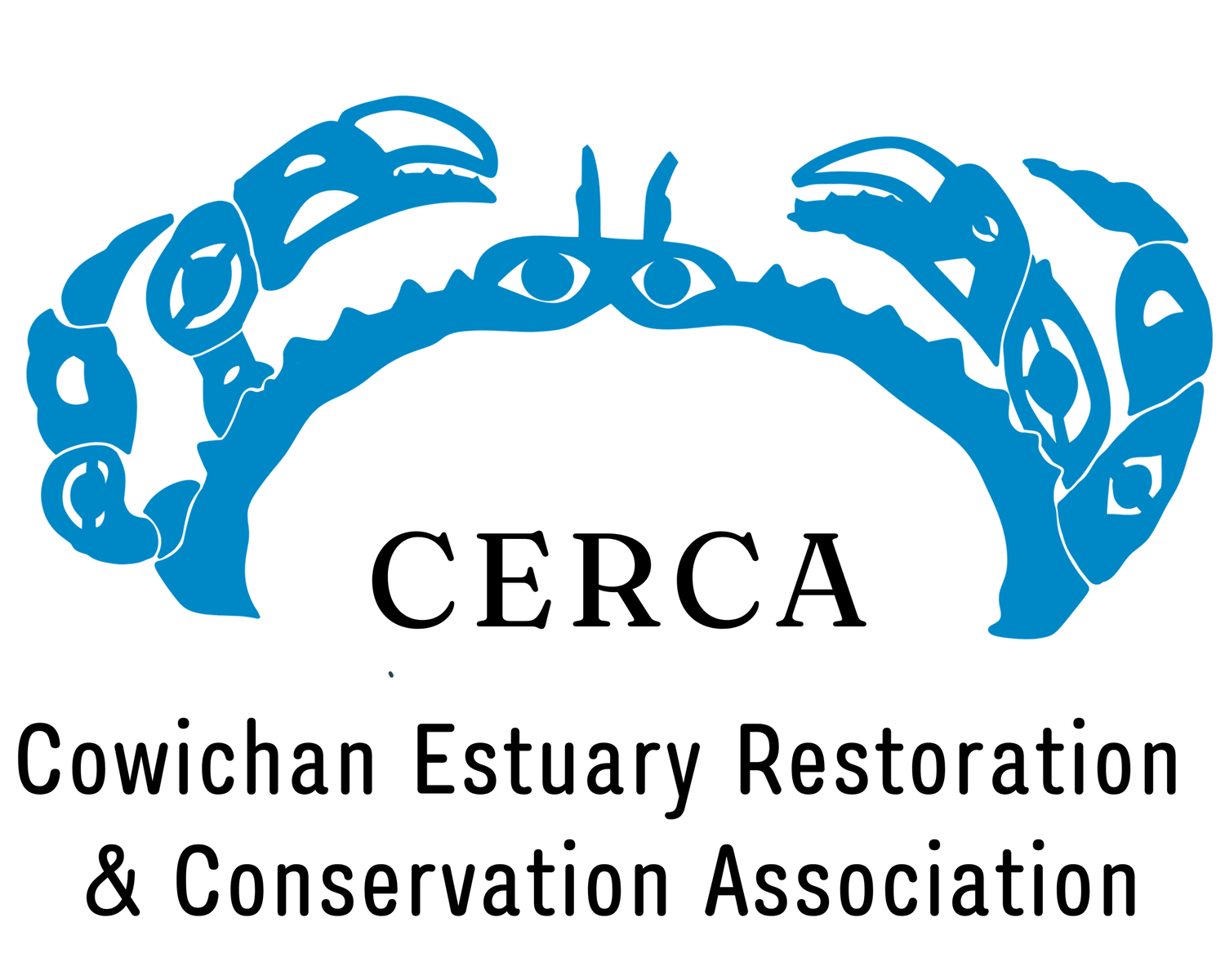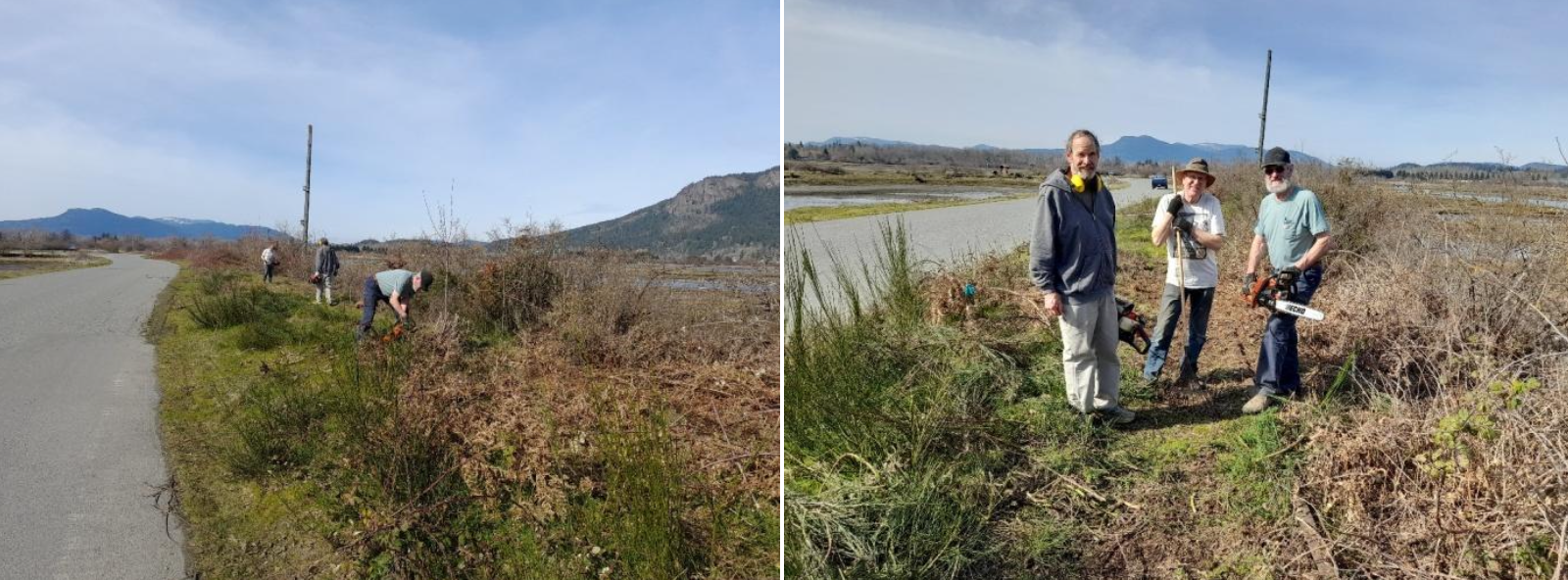Letter from the Chair, January to April 2024
Letter from the Chair, January to April 2024
As in previous years, the first two months of the new year were relatively quiet with CERCA business mostly confined to correspondence and telephone calls following up on ongoing pro- jects and preparing new activities. After the Board approved the 2024 Work Program at a meet- ing in late February, the month of March proved to be very busy as reported below. For the 2024 Activity Schedule I invite you to visit CERCA’s website.
On-going Projects
Micro-Plastics Project Phase II: Zeinab Zoveidadianpour started the second and final year of her postdoc fellowship awarded by Mitacs for CERCA’s Phase II Microplastics Project of the Cowichan and Comox Estuaries. She recently finished the analysis of all sediment and bio- samples collected and processed in 2023 and January 2024. She is currently elaborating the final report on the Phase II findings comparing the Cowichan-Koksilah and Comox results. Specifically (a) microplastics types, (b) their distribution, and (c) accumulation for both the sediment and bio-samples (i.e. clams and sand lance). I will produce a summary report on the results for the Cowichan-Koksilah Estuary and its tributaries with emphasis on samples taken from the estuary tributaries above and below the sewage outfall to be published on the CERCA website. Unfortunately, however, the results appear not to allow for conclusive suggestions regarding the origin of microplastics as we had hoped for.
Upgrading and Extending CERCA’s Self-guided Estuary Nature Trail: CERCA received a donation of $500 from our visiting friends Baerbel and Friedemann Schulz for the extension of the trail as originally planned in 2016. . Thanks to the intervention of Bruce Coates CERCA fi- nally received the green light from Western Stevedoring to go ahead with the extension. Using the services of Roy’s bobcat Brush Cutter the trail was cleaned up and the extension completed by mid-March. John Shaw and Luke Downs volunteered to remove debris left by the bobcat’s brush-cutting. As in previous years, the first two months of the new year were relatively quiet with CERCA business mostly confined to correspondence and telephone calls following up on ongoing pro- jects and preparing new activities. After the Board approved the 2024 Work Program at a meet- ing in late February, the month of March proved to be very busy as reported below. Although most of the trail extension could be cleared by the side cutter of the bobcat, the broom proved to be too flexible to be chipped. This was accomplished a few days later with the help of our members Jerome Webster, Steve Kirly, John Shaw, and my wife Beate using chainsaws, brush cutters and hedge trimmers graciously donated for this work by Cowichan Rentals.
3. Bat Monitoring Project: Cliff Stainsby in cooperation with Colten Payne from UVIC processed and analyzed the 2023 bat data collected by the six volunteers using CERCA’s Echo Meters. The data collected by the other group using the more sophisticated recording equipment are stored until the rather complex software to interpret the stored sonograms becomes available. Cliff and Bernhard Juurlink are in the process of producing the final report on last year’s data. Meanwhile, Cliff has prepared a PowerPoint to be presented at a meeting to be organized jointly with the Cowichan Valley Naturalists with invitations extended to all volunteers who have participated in the project to date, and CERCA and CVNS members. Based on the positive response to the project, eight new persons were located for the 2024 monitoring season. In late March an instruction session was held to familiarize the new group with the use of the Echo Meters and the processing of monitoring data. We decided to record four nights per month at each location starting April 1 until the end of October. The monitoring locations chosen for the 2024 season cover six of the ten habitat- and sub-habitat types identified for the Cowichan Watershed. Based on the increasing popularity of the bat project CERCA in cooperation with Cowichan Tribes will participate in a funding proposal under the Pacific Region Habitat Stewardship Pro- gram for Species at Risk (HSP) a program initiated by the Federal Ministry of Environment and Climate Change. The proposal will be elaborated by Chris Steger with a focus on bat roost tree identification within the Cowichan/Koksilah watershed. If approved funding will be available for the 2025 season. The project intends to link aquatic and terrestrial riparian management by fo- cusing on the roost trees of bats; the latter can act as an umbrella species group for other cavity nesters (e.g., woodpeckers). The goal is to educate community members and decision-makers through scientific studies and other educational tools that demonstrate the use of riparian and an- cient forest wildlife trees by bats and provide options for conservation.
4. Forage Fish Habitat and Dungeness Crab Larvae Monitoring: These two Citizen Science Projects have entered their third and fourth year respectively; the latter being an initiative of the HAKAI Institute, the other of the Vancouver Island University (MABBI). Bill Heath will con- tinue to lead both projects involving students from the Cowichan Secondary School. Monitoring the light trap used for the crab larvae count will be shared with the Nature Center. The trap will be checked three times per week from April 15 to September. Bill gave presentations on the pro- ject to the Cowichan Valley Naturalists and also offered it to the Shawnigan Lake School. Bill’s PowerPoint Presentation is also published on CERCA’s Website.
5. Saw Logs Washed up onto Mariners Island: In March 2023 we conducted a drone survey of Mariners Island to identify the number of logs washed up during the past seven years since CERCA’s major clean-up in 2016 when approximately 10,000 saw logs were removed from the 30 acres salt marsh. The remarkably fast vegetation recovery (within two years!) was a great success reflecting nature’s resilience when given a chance. However, meanwhile, several hun- dred logs have been washed up again. The saw logs originate from log booms destined for the Cowichan Bay sawmill. Meetings with Western Forest Products Mill personnel to discuss the urgent need for log removal before they damage the salt marsh vegetation have been unsuccessful to date.
In March 2024 CERCA member Adrian Fletcher, a commercial drone operator, graciously con- ducted a drone survey free of charge producing high-resolution imagery used for the elaboration of an orthophoto. A 10 x 10-meter square grid was superimposed onto the orthophoto, enabling an easy identification of logs. The total number identified amounted to approximately 600. A meeting with WFP personnel is scheduled to re-address the problem which has to be solved soon. Since log removal has to be completed before green-up and the bird breeding season, it may be already too late for 2024. CERCA therefore will insist on a firm commitment by WFP to remove the logs in early 2025.
Contamination from Westcan Terminal: Bernhard Juurlink continues to remind Government agencies of their enforcement responsibility, but unfortunately with little success so far. The lat- est response by the Ministry of Environment and Climate Change to Bernhard’s inquiry from a March letter was a rather vague note that an inspector of the Ministry will look into the problem of uncontrolled storm water run-off and unprotected creosoted wood stored on site.
Blackley Farm Dyke Trail: CERCA’s request to the Ministry of Forest and Lands for a permit to remove broom and invasive species from Blackley’s dyke has turned into a bureaucratic nightmare. You may recall that CERCA and the Cowichan Valley Naturalists joined forces in an attempt to cut the broom before this year’s spring green-up. After countless telephone calls and e-mail correspondence, it appears that we finally got green light (as of today, April 2) to start broom bashing. I was told by the Chief Dyke Inspector of BC that The Ministry does not object to the broom removal but can’t provide an official permit, in the absence of applicable policies and forms. He promised to try solving the access problem which is only possible via the locked gate. We will insist that our work can only start if we receive a key to the gate lock. There is a glimmer of hope that at least some broom-cutting can still be done this spring.
Financial: According to our treasurer Margaret Riess the CERCA account balance is about $ 18K. This includes $8K from the Canadian Wildlife Service for our proposed glass fiber project, and $500 by the Schulz family for the trail extension, The $2.9K donation by North Cowichan allocated to the Microplastics Project will be paid in May. The Cowichan Valley Naturalists promised to contribute $400 to the trail maintenance expense (the invoice received by Roy’s Bobcat Service amounts to $1.1K).
Since our operational budget has to be covered by membership fees, I kindly ask you to pay your 2024 dues if you have not done yet. The insurance premium constituting the largest item of our operational budget has significantly increased this year,. I noticed that Margaret had recently sent a reminder on how to pay the annual dues. Thanks, Margaret for staying on top of CERCA’s budget!.
New Projects
Cowichan Estuary Glass Fiber Assessment: CERCA has reached an agreement in principle with Dr, Tamara Kazmiruk to be the lead scientist on the proposed glass fiber assessment project of the Cowichan Estuary. This will commence with the collection of biofilm samples from the in- tertidal area of the estuary by early May. I will send a request for volunteers to assist in the sam- ple collection as soon as dates can be confirmed. The samples will be processed and analyzed by Tamara using the laboratory facility of Dr. Leah Bendell at Simon Fraser University. It will be interesting to find out whether glass fiber contamination poses a problem in the estuary. The results of the analysis are not to be available until late summer.
With best wishes for a pleasant spring season and sufficient rain to refill our aquifers,
Goetz Schuerholz
Chair CERCA




